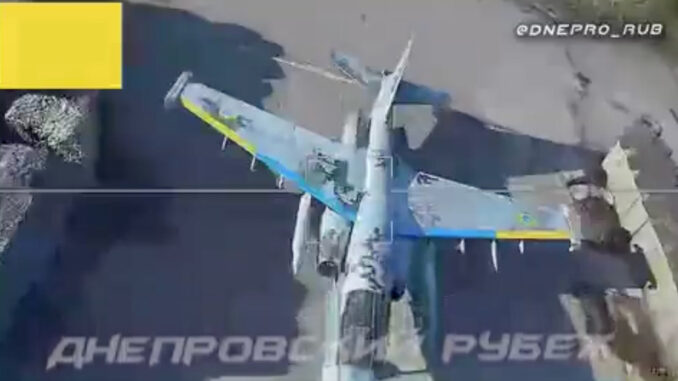F-16 Decoys With Ukrainian Air Force Insignia Unveiled In Denmark; Could Be Used To Deceive Russian Forces

Photos of a Czech-produced inflatable decoy of F-16 fighter jets marked with Ukrainian Air Force insignia have surfaced online.
These decoys could be strategically deployed to mimic the presence of actual combat aircraft at Ukrainian airfields, potentially luring Russian forces into targeting these fake assets instead of genuine military hardware.
The Ukrainian-marked F-16 decoy is currently being showcased at the Industry Days defense exhibition in Denmark, an event organized by the Danish Ministry of Defense Acquisition and Logistics Organization (DALO).
The full-scale inflatable replica closely mimics the real fighter jet, complete with a transparent ‘cockpit canopy,’ wingtip stores, and a centerline ‘fuel tank.’ This realistic appearance adds to its potential effectiveness in deceiving adversaries.
AfriPrime App link: FREE to download...
https://www.amazon.com/Africircle-AfriPrime/dp/B0D2M3F2JT
The decoy is the creation of Inflatech, a Czech company known for its expertise in manufacturing inflatable military decoys. The company has already supplied Ukraine with decoys of various military equipment, enhancing Ukraine’s ability to mislead and confuse enemy forces.
The company’s portfolio includes more than 30 different inflatable military decoys, ranging from tanks and armored vehicles to artillery pieces and aircraft.
Notable among their offerings are inflatable replicas of the US-made HIMARS rocket systems, Russian-made Su-27 and Su-30 Flanker aircraft, as well as the US-made UH-60 Black Hawk helicopter.
The company, situated in the northern town of Decin, is capable of manufacturing up to 50 decoys per month. These decoys are distributed to various countries, although the specific recipients are not disclosed.
Importantly, every export of these decoys must be sanctioned by the government of the NATO member state where Inflatech operates. Inflatech’s business has seen significant growth, with the company reporting a more than 30 percent increase in sales as of March 2023 compared to the previous year.
This surge is expected to continue, with projections indicating double-digit growth for at least the next three to five years. This increase in demand underscores the value of such decoys in modern warfare, particularly in conflicts where deception and misdirection can play a critical role.
It is still unclear whether the F-16 decoys will be dispatched to Ukraine. The presence of Ukrainian Air Force markings on these decoys might be intended to attract attention and generate interest in the product.
The exact cost of a single decoy remains uncertain, but previous reports indicate that decoys originally designed for training purposes can be priced as high as $100,000 each.
AfriPrime App link: FREE to download...
https://www.amazon.com/Africircle-AfriPrime/dp/B0D2M3F2JT
Using Decoys To Deceive Russian Forces
The inflatable decoy’s emergence at the defense exhibition in Denmark comes as the first batch of real F-16s have arrived in the country, albeit in limited numbers.
According to reports, only six Ukrainian pilots are currently qualified to fly these jets, and their proficiency may be restricted to air defense mission roles. Nevertheless, the arrival of these aircraft represents a major upgrade in Ukraine’s military capabilities.
However, the presence of real F-16s has not gone unnoticed by Moscow. Russian authorities have asserted that Ukrainian F-16s will ultimately be rendered ineffective by Russia’s advanced weaponry.
This assertion underscores the necessity for Ukraine to employ various strategies to protect its new assets. Among these strategies, the use of decoys has proven to be an effective method for Ukraine, which has already established a successful history of employing such tactics to mislead Russian forces.
During the early phase of the war, Ukraine began using decoys of the Stugna anti-tank guided missile system, with early versions made from metal, plastic pipes, and wood.

Ukraine subsequently deployed wooden decoys resembling HIMARS rocket systems, drawing the interest of Russian forces. Interestingly, Russia claimed to have destroyed more HIMARS than Ukraine actually received, which clearly indicates the role of decoys.
The report indicated that Russia used at least ten Kalibr cruise missiles, each costing $6.5 million, on these decoys during the initial phase of HIMARS deployment.
Ukraine also began deploying aircraft decoys to lure Russian forces. One notable incident from last year involved a highly realistic, non-inflatable decoy of a Ukrainian Su-25 Frogfoot ground-attack aircraft, which was destroyed by a Russian Lancet loitering munition.
The decoy was so convincing that Russia reported hitting an actual Su-25, demonstrating the effectiveness of Ukraine’s deception efforts.

While it remains uncertain whether the Czech manufacturer will supply inflatable F-16 decoys to Ukraine, the EurAsian Times previously suggested that Ukraine was already engaged in producing mock-ups of F-16 fighter jets as part of its broader deception strategy.
Meanwhile, Russia has also been taking measures to safeguard its aircraft on the ground in response to repeated attacks from Ukrainian long-range one-way drones. These include the use of unusual tire arrangements on airfields designed to mislead missile seekers’ image-matching algorithms and the painting of aircraft silhouettes in parking revetments.
AfriPrime App link: FREE to download...
- Questions and Answers
- Opinion
- Story/Motivational/Inspiring
- Technology
- Art
- Causes
- Crafts
- Dance
- Drinks
- Film/Movie
- Fitness
- Food
- الألعاب
- Gardening
- Health
- الرئيسية
- Literature
- Music
- Networking
- أخرى
- Party
- Religion
- Shopping
- Sports
- Theater
- Wellness
- News
- Culture
- War machines and policy




